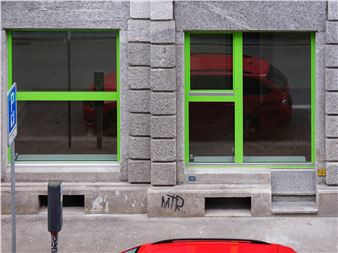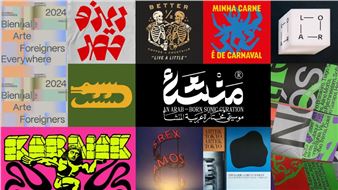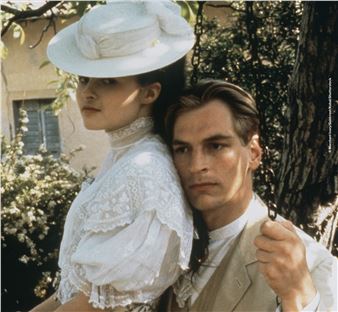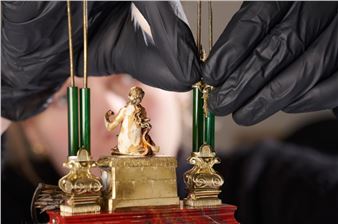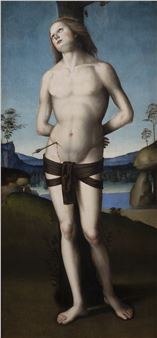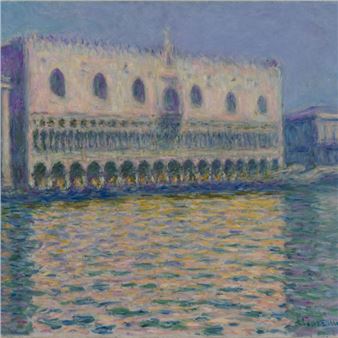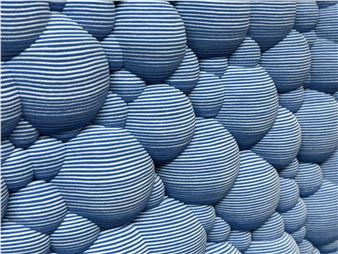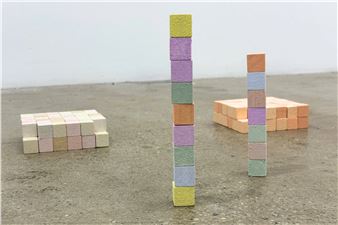Maddy Parrasch & Emma Soucek
Maddy Parrasch and Emma Soucek did in fact finish one anotherвҖҷs sentences, but that phrase trivializes one of the best art romances IвҖҷve seen firsthand: they also finished one anotherвҖҷs paintings and started one anotherвҖҷs thoughts. They contributed physical material, imagery, inspiration, criticism, advocacy, and confidence to one anotherвҖҷs work. They traveled together, borrowed from one another and from the rest of their extraordinary group of friends, and shared pretty much everything, pooling experiences to maximize returns. The last time they were physically together, they interviewed one another. How many artists get to know, even for a while, the perfect member of their audience? Maddy posted a hand-written text drawing on Instagram: вҖңDearest Emma, I hope you blow up.вҖқ This two-person show evolved directly from that sentiment.
The work here all speaks to a desire to compress material, image, surface, ground, and support into a unified image-object. Emma and Maddy, visiting Assisi and Padua in 2016, recognized GiottoвҖҷs frescos as a realization of that shared aspiration. In MaddyвҖҷs works the impulse plays out in experimentation with ceramic glazes, 3D and UV printing, monoprints, and other solutions to the problem of how to inextricably fuse a picture into material, rather than laying it on top. EmmaвҖҷs paper pulp paintings meld color, drawing, and scraps of reference into constellations of deliberately macerated content. They go about it differently, but in both artistsвҖҷ works the results are simultaneously minimal and maximal, heavy and light, corporeal and ephemeral, elegant and abject.
The work attests to an idea of authenticity that doesnвҖҷt preclude self-awareness, humor, or even self-deprecation. It seems to appeal to an idea of soulfulness that, rather than presuming to situate itself in some rarified elsewhere, instead revels in the moment and place of the workвҖҷs making (often the studio floor). The descriptive, almost diagrammatic images in MaddyвҖҷs artist-framed grids of monoprint line drawings ground us in their socially inscribed and physically embodied situation (and our own), as do the legible collage elements (fragments from drawings, the artworks of friends and role models, and souvenirs and ephemera from her life) that emerge from the soft geometry, both sacred and profane, of EmmaвҖҷs pulps.
In capturing this material, the works do serve as reliquaries, but rather than a fiction of permanence and fixity they offer a view of our memories and strategies for preservation as fragile, flowing, brittle, and always in flux. Maddy, who first started college as an archaeology major, talked and wrote about excavation and its connection to ceramics. She described her works as вҖңclues to trace a broken train of thought,вҖқ and the way this phrase tasks both artist and viewer with digging up, sifting through, piecing together, and continually reassembling fragments of meaning seems equally applicable to EmmaвҖҷs work.
Anyone could be forgiven for wanting to turn this show into an elegy, but thatвҖҷs not the workвҖҷs mode: thereвҖҷs no one narrative, and certainly no summation. Yes, this show connects us to a heartbreaking story about two young artist-friends who loved and contributed profoundly to one anotherвҖҷs work, but the vigor, exuberance, and emotional range of the actual objects in the gallery demand we not be satisfied with that conclusion, or any other. Please, look.
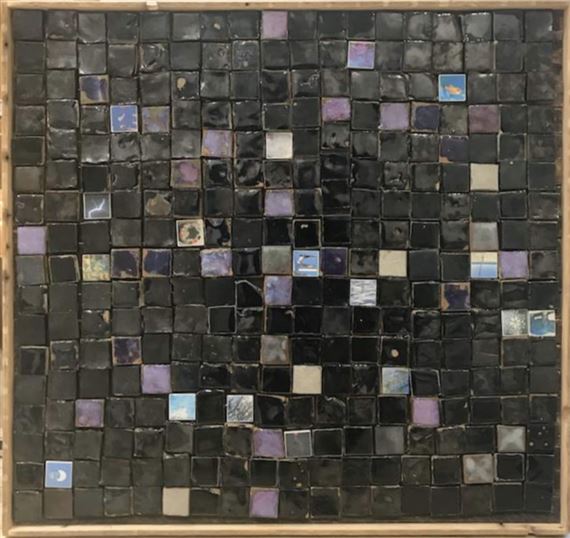
Recommended for you
Maddy Parrasch and Emma Soucek did in fact finish one anotherвҖҷs sentences, but that phrase trivializes one of the best art romances IвҖҷve seen firsthand: they also finished one anotherвҖҷs paintings and started one anotherвҖҷs thoughts. They contributed physical material, imagery, inspiration, criticism, advocacy, and confidence to one anotherвҖҷs work. They traveled together, borrowed from one another and from the rest of their extraordinary group of friends, and shared pretty much everything, pooling experiences to maximize returns. The last time they were physically together, they interviewed one another. How many artists get to know, even for a while, the perfect member of their audience? Maddy posted a hand-written text drawing on Instagram: вҖңDearest Emma, I hope you blow up.вҖқ This two-person show evolved directly from that sentiment.
The work here all speaks to a desire to compress material, image, surface, ground, and support into a unified image-object. Emma and Maddy, visiting Assisi and Padua in 2016, recognized GiottoвҖҷs frescos as a realization of that shared aspiration. In MaddyвҖҷs works the impulse plays out in experimentation with ceramic glazes, 3D and UV printing, monoprints, and other solutions to the problem of how to inextricably fuse a picture into material, rather than laying it on top. EmmaвҖҷs paper pulp paintings meld color, drawing, and scraps of reference into constellations of deliberately macerated content. They go about it differently, but in both artistsвҖҷ works the results are simultaneously minimal and maximal, heavy and light, corporeal and ephemeral, elegant and abject.
The work attests to an idea of authenticity that doesnвҖҷt preclude self-awareness, humor, or even self-deprecation. It seems to appeal to an idea of soulfulness that, rather than presuming to situate itself in some rarified elsewhere, instead revels in the moment and place of the workвҖҷs making (often the studio floor). The descriptive, almost diagrammatic images in MaddyвҖҷs artist-framed grids of monoprint line drawings ground us in their socially inscribed and physically embodied situation (and our own), as do the legible collage elements (fragments from drawings, the artworks of friends and role models, and souvenirs and ephemera from her life) that emerge from the soft geometry, both sacred and profane, of EmmaвҖҷs pulps.
In capturing this material, the works do serve as reliquaries, but rather than a fiction of permanence and fixity they offer a view of our memories and strategies for preservation as fragile, flowing, brittle, and always in flux. Maddy, who first started college as an archaeology major, talked and wrote about excavation and its connection to ceramics. She described her works as вҖңclues to trace a broken train of thought,вҖқ and the way this phrase tasks both artist and viewer with digging up, sifting through, piecing together, and continually reassembling fragments of meaning seems equally applicable to EmmaвҖҷs work.
Anyone could be forgiven for wanting to turn this show into an elegy, but thatвҖҷs not the workвҖҷs mode: thereвҖҷs no one narrative, and certainly no summation. Yes, this show connects us to a heartbreaking story about two young artist-friends who loved and contributed profoundly to one anotherвҖҷs work, but the vigor, exuberance, and emotional range of the actual objects in the gallery demand we not be satisfied with that conclusion, or any other. Please, look.
Artists on show
Contact details

Related articles
On a hot Brooklyn afternoon, Emma Soucek and I met at Safe Gallery to discuss her two-person show with the late Maddy Parrasch.
The work of Emma Soucek and the late Maddy Parrasch at Safe Gallery not only braves the space of the grid, but also revels in its inconsistencies and hiccups.

 ARTISTS
ARTISTS







